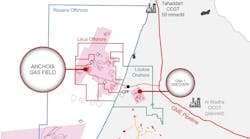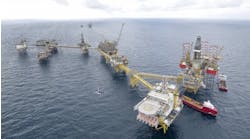Pam Boschee • Houston
Africa
Pioneer Natural Resources Co. says development activities have begun on its South Coast gas project offshore South Africa. Pioneer is partnering with PetroSA, the national oil company of South Africa, to jointly develop the South Coast gas fields to provide feedstock for PetroSA’s onshore gas-to-liquids (GTL) plant in Mossel Bay.
Pioneer holds a 45% working interest in the project, and PetroSA has a 55% working interest and is operator.
Since 2003, Pioneer and PetroSA have been producing oil from the Sable field while re-injecting associated gas. The South Coast gas project will include the subsea tieback of gas from the Sable field and six additional gas accumulations to the existing production facilities on the F-A platform for transportation via existing pipelines to the GTL plant.
Production is expected to begin during the second half of 2007 and increase to an average of approximately 100 MMcf/d of gas and 3,000 b/d of condensate over the initial phase of the project through 2012.
Engineering plans for subsea systems, pipelines, umbilicals, and surface equipment modifications are being finalized. Development drilling is scheduled to begin this month.
• • •
PA Resources AB has entered into a contract with Diamond Offshore to charter the 300-ft jackup drilling rigOcean Spurfor 12 months.
The rig is expected to be available in the Gulf of Gabes, Tunisia, in 1Q 2006 when it will start the planned drilling of up to three new production wells at the producing field Didon. The new production wells will be drilled and completed on the new platform currently being installed at Didon.
The previously disclosed production target for Didon of 20,000 b/d of oil following completion of the additional production wells remains in place and should be reached during 2Q 2006.
The drilling program will include an exploration well in the Zarat permit area. In addition, the company is evaluating an appraisal well at the Elyssa discovery as part of the plan to accelerate the development program for this discovery.
Asia-Pacific
Brunei Shell Petroleum Co. (BSP) has reported its fifth successive discovery in the Seria Shallow Marine North Flank area.
BSP is a 50-50 joint venture between the Brunei government and Royal Dutch/Shell.
“More than 100 m of net oil sands were found. The well will be completed in 2006 to provide early production from the Seria North Flank area,” the company said in a statement.
The Seria field produces 25,000 b/d, but BSP did not give an estimate on reserves from the new discovery.
BSP, the main producer in Brunei, averaging output of 200,000 b/d, has planned five more wells in the area over the next two years.
• • •
The Thai government is expected to lease out three petroleum exploration concessions in the Gulf of Thailand to Chevron, Total, and PTT Exploration and Production (PTTEP).
Chevron has won the concession to block G4/48 on August 15, and its joint venture with PTTEP won block G9/48. Total E&P has won block G12/48 in partnership with PTTEP Siam.
The three companies will explore the blocks for three years, and in case of a commercially viable hydrocarbon discovery, will have to apply for 20- to 30-year concessions for oil and gas production.
Americas
The lower hull of the megaP-52 floating production unit (FPU), designed to produce 180,000 b/d from the Campos basin field, will leave Singapore between mid-January and early February for Brazil.
Singapore’s Keppel FELS Ltd. built the hull through a 75-25 joint venture (JV) with Technip.
The 80,000-ton lower section of the $775-million FPU was completed in Keppel FELS’ Singapore yard, while the upper deck is being built at Keppel FELS yards in Brazil.
The Keppel FELS-Technip JV will mate the semisubmersible FPU by end of 2006 for production from early 2007, said Keppel FELS officials at the commissioning of theP-52 hull in Singapore in mid-December.
The JV won the bid to build the platform in two parts in December 2003.
TheP-52 project involves the detailed engineering, procurement, and construction of the FPU with capacity to operate in water depths of 1,800 m.
Keppel FELS dispatched the column nodes of theP-51FPU, a sister unit, in mid-December. The nodes will be joined with the rest of the unit in a fashion similar to that used for theP-52.
Petrobras awarded the consortium theP-51 contract five months after the P-52 contract award, departing from its original plan to award the contracts to separate contractors in view of the projects’ complexity and size, says Keppel FELS.
Special-purpose company CDC has signed a contract with Petrobras to build the topside of theP-53 FPSO. The FPSO will produce oil at the Marlim Leste field in the Campos Basin, located 120 km off the coast of Rio de Janeiro state at a water depth of 1,250 m.
CDC leased theP-53to Petrobras. Prior to hand-over, CDC will employ Brazilian engineering firms Queiroz Galvão, Ultratec, and IESA to convert theSettebelloship into the FPSO.
Once converted, theP-53 will have the capacity to produce 180,000 b/d of oil and 6 MMcm/d of natural gas.
In addition to the three engineering firms, CDC will also employ Rolls Royce to supply the power generation unit and Dresser-Rand to provide the natural gas compression unit. CDC’s total investment in the FPSO is reported to be $950 million.
The FPSO is scheduled to start producing heavy crude from 15 production wells in 2008. Production will be taken to shore via an underwater line and a pumping platform known as PRA-1 that has also been contracted by Petrobras.
• • •
Vulcan Minerals Inc. successfully bid for parcel 7 offshore Western Newfoundland in the recent call for bids by the Canada Newfoundland and Labrador Offshore Petroleum Board (CNLOPB).
Vulcan submitted a joint bid on a 50/50 basis with a private company. The exploration license will have an initial five-year term extendable for four additional years if a well is drilled in the initial term.
Parcel 7 covers 395,000 acres of the Anticosti basin in the Gulf of St. Lawrence immediately adjacent to the West Coast of Newfoundland.
The parcel contains in excess of 1,200 line km of seismic data acquired by Mobil Oil in the 1990s.
A preliminary in-house assessment of interpreted seismic data filed with the CNLOPB confirms the presence of several large structures, at least one of which potentially exceeds 150 sq km in area.
• • •
Suriname’s state oil company Staatsolie has launched its 2006 international bid round for three exploration blocks in the southeast of the country’s offshore territory in the Suriname-Guyana Basin, the company said in a statement. The bids are on the 2,552-sq km block 15, the 3,407-sq km block 36 and the 8,758-sq km block 37.
Details of the contract model will not be available until February 1, but the winners will have a controlling interest, according to Staatsolie E&P Contracts Manager Marny Daal-Vogelland.
The deadline to submit bids is July 2, and bids must be accompanied by a company profile, technical and financial reports for the last two years and the company’s latest audit report. Staatsolie plans to award the blocks by August 2 and sign the production sharing contracts in September 2006.
Staatsolie made available on January 1 a data package of 2D seismic that they acquired and processed in 2005. The package is available for $25,000, but interested companies are not obliged to purchase the data package.
Prior to the 2D seismic evaluation, no exploration had been done on the area, Daal-Vogelland noted. The data indicates several leads that are more suggestive of oil reserves than gas.
The company’s 2005 activities were mainly centered on offshore developments. The 2D seismic studies of these three offshore blocks and the discovery of the Tambaredjo Northwest onshore oil field, contributed to the additional 30 MMbbl to the country’s proven reserves.
The Suriname-Guyana basin is considered to be highly prospective for oil and gas as the United States Geologic Survey (USGS) estimates possible reserves in this basin of 15 Bbbl, according to the company statement.•


